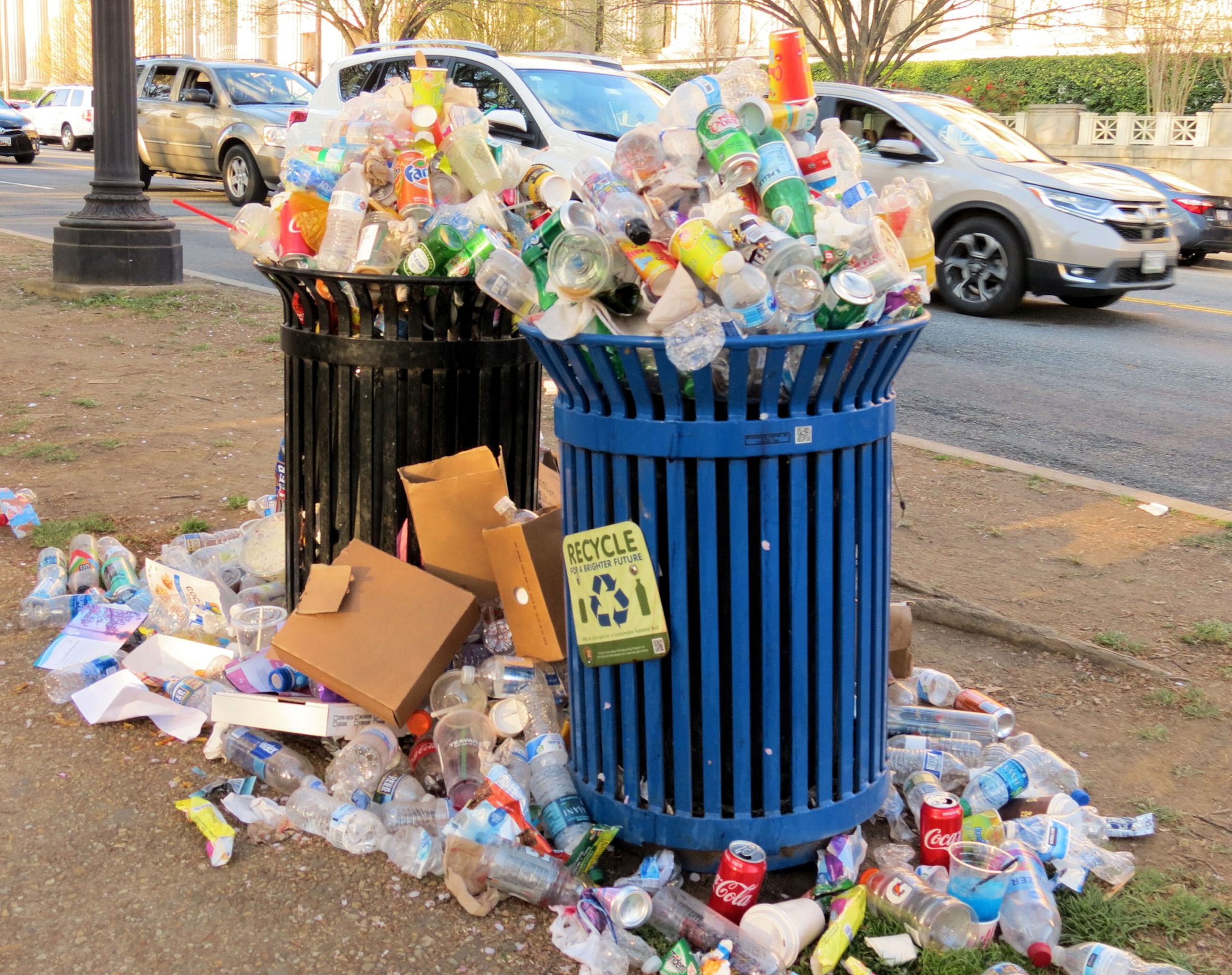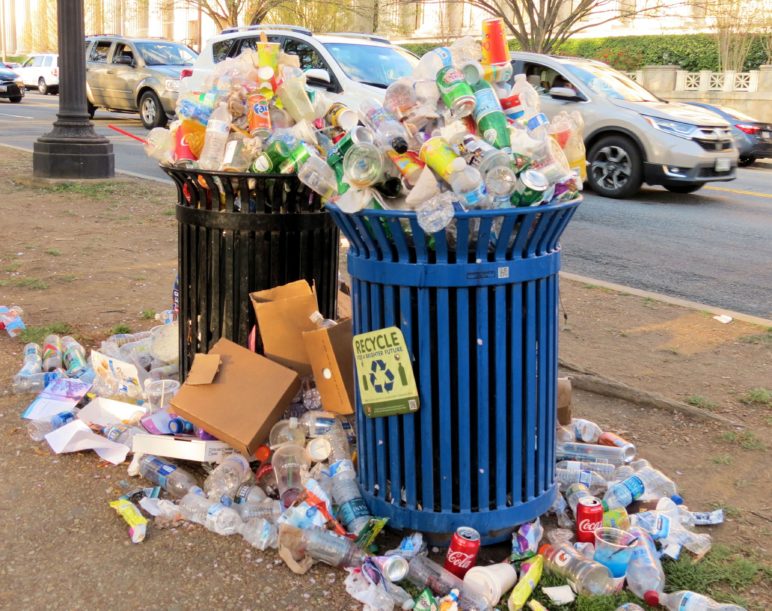Right up until the coronavirus pandemic hit, the Northwest was near the forefront of the global movement against plastics. Scores of cities in the region had banned various single-use products, and in March, the Washington State Legislature banned plastic grocery bags statewide, effective January 2021. The laws in Cascadia were part of a wave of bans on disposable consumer plastic products—especially straws and bags—that swept across North America and Latin America. This wave has even extended to China, the world’s biggest consumer of single-use plastics.
Now many of those laws are in jeopardy or have been temporarily suspended, with grocery stores and restaurants offering takeout and eschewing reusable products in favor of single-use plastics that are believed to be more hygienic. This response may be understandable as a short-term public health measure, but it carries a serious long-term risk. With 335 million tons of plastic produced annually—and 9 million tons of it ending up in the ocean—plastic is widely recognized as a major threat to the climate, wildlife, and oceans. Scientific studies have found plastic fibers almost everywhere—in the stomachs of whales, in tap water, and even in table salt. And recent research shows that solar radiation degrades plastic, causing it to emit climate-warming methane.
Bans on plastic use are one of the few ways to reduce the manufacturing of plastic in the first place. The world’s plastic problem is not only a problem of proper waste management (a serious issue in a few countries) but also one of the very existence of plastic. Before plastics become products (lawn chairs, thin grocery sacks, or hundreds of other items), they often start as nurdles. Designed for ease of transport and versatility in manufacturing, these tiny pellets are the intermediate stage between raw petrochemicals like ethane and finished consumer goods. Roughly the size of a lentil, nurdles are considered microplastics—diminutive in stature but huge in its potential threat to the ecosystem. Researchers estimate that each year approximately 230,000 tons of nurdles end up in the environment, accidentally spilled or otherwise released by the plastics industry.
Researchers estimate that each year approximately 230,000 tons of #nurdles end up in the environment, accidentally spilled or otherwise released by the plastics industry.

Given that a single nurdle weighs only about 20 milligrams, this means that more than 10 trillion tiny plastic pellets are entering the world’s rivers and oceans every year. Birds and sea creatures often mistake nurdles for food, and their ingestion can lead to poisoning (in part because the pellets can absorb toxic chemicals like DDT) or starvation, as nurdles cannot be digested and can fill up an animal’s stomach over time.
The full effects of these harmful bits of plastic (which can break down into even smaller microplastics) are still unknown, but laboratory evidence indicates that they are toxic to phytoplankton, the foundation of the ocean’s food chain. Through photosynthesis, this microscopic marine alga absorbs nearly half of the carbon dioxide in the atmosphere. Microplastic disrupts phytoplankton’s feeding, reproduction, and metabolism. It also disrupts the vital role of zooplankton, which feed on phytoplankton, in transporting carbon to the ocean floor in the form of fecal pellets.
Nurdles are too small to be effectively cleaned up once they escape into the environment, yet they would not exist in the vast quantity they do without the global demand for plastic products. Petrochemical companies ship billions upon billions of nurdles from production sites to factories all over the world that transform them into the finished products we use and often quickly dispose of. Because nurdles are so small and inexpensive to produce—and because their escape is so lightly regulated—the industry appears willing to accept a certain level of loss as the cost of doing business.
Some nurdle pollution results from shipping spills. In 2017 a hurricane at the Port of Durban in South Africa caused two container ships to collide, sending 49 metric tons of nurdles into the ocean. The translucent beads quickly spread along more than 1,200 miles of coastline, with some landing on the beaches and some making it as far as Western Australia over the following year. Months after the spill, South African authorities had retrieved only about 23 percent of the spilled nurdles, with the rest likely never to be recovered.
Other times, nurdle pollution results from the manufacturing process. A peer-reviewed study on the southwest coast of Sweden found that a polyethylene producer in the industrial town of Stenungsund releases millions of pellets annually. It’s the same story in Scotland, where a large petrochemical manufacturing site outside Edinburgh yields a heavy concentration of nurdle pollution in the Firth of Forth, a nearby coastal estuary. So heavy is the nurdle pollution there that during a beach cleanup, volunteers collected more than 450,000 pellets in just over two hours.
In the most troubling cases, plastics manufacturers may dump nurdles into the environment. This is what appears to have happened on the US Gulf Coast, where the petrochemical giant Formosa Plastics was forced to pay a $50 million settlement after losing a lawsuit alleging that the company had illegally dumped nurdles and other pollutants into Lavaca Bay in Texas. The suit was bolstered by the work of citizen scientists with the Nurdle Patrol, a project of the University of Texas Marine Science Institute, who carefully gathered data about the extent of the problem.
A group of citizen scientists based in Scotland started the Great Nurdle Hunt to find the minute plastic beads on 84 percent of the beaches they surveyed, including beaches in Abu Dhabi, Ecuador, and South Africa. Their research suggests that once in the marine environment, nurdles travel practically everywhere and that even the world’s most protected sanctuaries are not immune. In March 2019, for example, 11 volunteers collected more than 1,000 nurdles on the Galapagos Islands in less than two hours.
There are some industry-sponsored efforts to self-regulate nurdle pollution, but these appear to be milquetoast at best. Most notable is Operation Clean Sweep, a voluntary program that provides information to participating companies on best practices for reducing nurdle spillage, but there is no government follow-up or monitoring system to measure success. And membership is no guarantee of good behavior, as Formosa Plastics’ membership has shown.
In a world demanding more and more plastic, preventing nurdle pollution is not easy. In the United States, one logical step would be to enforce laws already on the books, like the Clean Water Act, which requires companies to obtain permission from regulators before they discharge pollutants into bodies of water. By defining nurdles as a pollutant, as California did in 2008, states could regulate and, in theory, prevent nurdle pollution at manufacturing sites.
But in an interconnected world of plastics manufacturing and shipping, the most effective solution to plastic pollution may be simple: use less.
Author’s update 5/26/2020: Newly published research in the journals Environmental Pollution and Global Change Biology indicate that the environmental impacts of microplastic are worse than previously understood. First, by using much finer nets to collect plastic (100 micrometers compared to the typical 500 micrometers), researchers recorded a 2.5-fold increase in the amount of microplastics in surface water, which implies that yet more plastic would be identified if even finer nets were used to collect data. Second, researchers found that Eurasion dippers, a predatory river bird species, ingested plastic first consumed by their prey and that the plastic transferred from adult dippers to their young during feeding. In other words, plastic ingested at the bottom of the food chain can travel up to predators.
Author’s update 8/27/2020: Desmog has depressing coverage of new nurdle contamination on the Mississippi River that resulted from a nurdle-fill shipping container falling off a cargo ship.
Zane Gustafson is a freelance researcher who holds a Master’s in Public Affairs with a focus in climate policy from the Evans School of Public Policy and Governance at the University of Washington. He also studies foreign affairs, political rhetoric, and American history.












Hristo Stoynov
I wonder how many readers caught that two container ships, even the largest ones in existence, cannot carry 49 million tons of cargo. The number is overestimated by at lest 100 times. Not that it makes a difference to the bottom line of this otherwise fine article.
Eric de Place
Good catch, Hristo!
Not sure how we added the word “million” to that line, but it was an error. We’ve corrected it.
Hristo Stoynov
It may be “tons” that is incorrect, used instead of “pounds”. Often numbers are cited in Millions of pounds, which is borderline manipulative because it makes the number seem larger. In this case 49 Million pounds would be about 25,000 tons – significant and within the capacity of typical cargo ships.
Frank Mancuso
I was likely the first person to address this in a series of lawsuits over 20 years ago. One case lasted 20 years and I can report on the cause but more importantly that it will be the cause of our demise long before anything else.
Mary Paterson
Thank you for this excellent article. My main comment is that the end of fossil fuels in our economy and infrastructure would also mean the end of new plastic manufacturing – another reason to work for the end of fossil fuels.
John Abbotts
Readers may be interested in this commentary by John Oliver, at https://www.youtube.com/watch?v=Fiu9GSOmt8E
He talks about the global pollution from plastics, and notes that the plastics industry’s urging to consumers to recycle fails to accept the industry’s responsibility to Reduce, before Reuse and Recycle.
All stay safe,